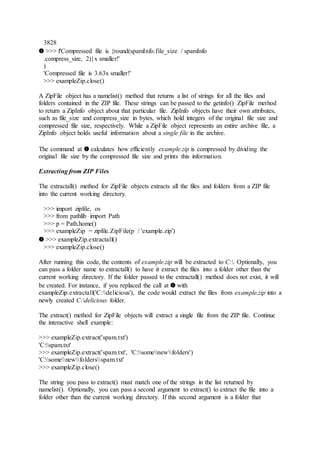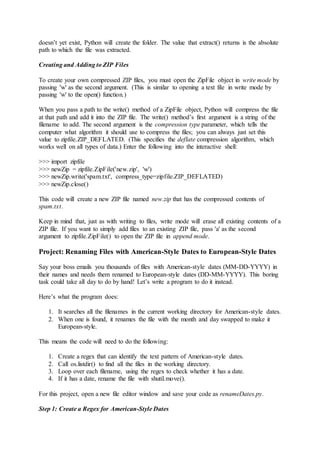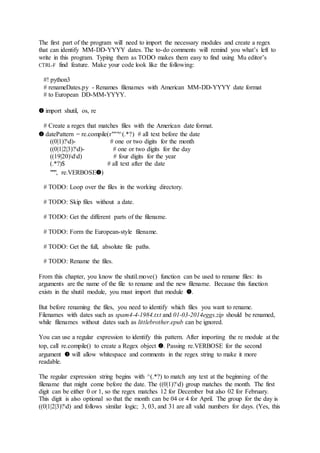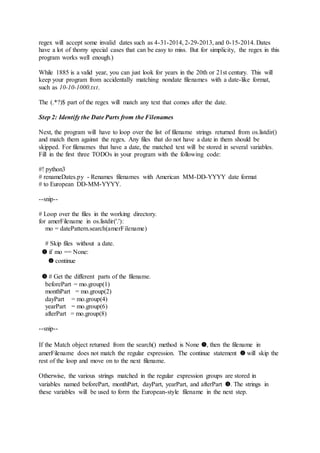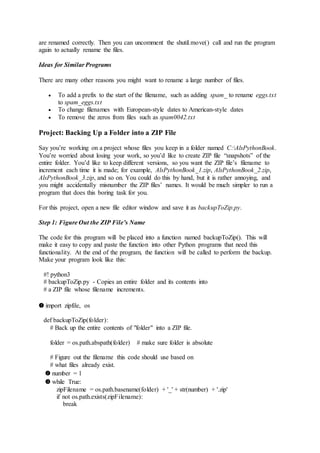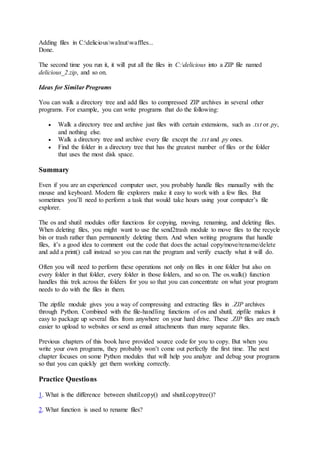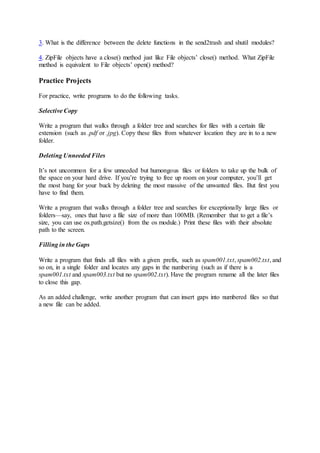This document discusses how to organize and manipulate files in Python. It introduces the shutil module, which contains functions for copying, moving, renaming, and deleting files. It describes how to use shutil functions like copy(), copytree(), move(), rmtree() to perform common file operations. It also introduces the send2trash module as a safer alternative to permanently deleting files. Finally, it discusses walking directory trees using os.walk() to perform operations on all files within a folder and its subfolders.
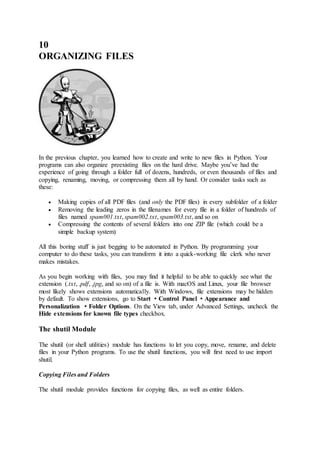

![>>> import shutil
>>> shutil.move('C:bacon.txt', 'C:eggs')
'C:eggsbacon.txt'
Assuming a folder named eggs already exists in the C: directory, this shutil.move() call says,
“Move C:bacon.txt into the folder C:eggs.”
If there had been a bacon.txt file already in C:eggs, it would have been overwritten. Since
it’s easy to accidentally overwrite files in this way, you should take some care when using
move().
The destination path can also specify a filename. In the following example, the source file is
moved and renamed.
>>> shutil.move('C:bacon.txt', 'C:eggsnew_bacon.txt')
'C:eggsnew_bacon.txt'
This line says, “Move C:bacon.txt into the folder C:eggs, and while you’re at it, rename that
bacon.txt file to new_bacon.txt.”
Both of the previous examples worked under the assumption that there was a folder eggs in
the C: directory. But if there is no eggs folder, then move() will rename bacon.txt to a file
named eggs.
>>> shutil.move('C:bacon.txt', 'C:eggs')
'C:eggs'
Here, move() can’t find a folder named eggs in the C: directory and so assumes that
destination must be specifying a filename, not a folder. So the bacon.txt text file is renamed
to eggs (a text file without the .txt file extension)—probably not what you wanted! This can
be a tough-to-spot bug in your programs since the move() call can happily do something that
might be quite different from what you were expecting. This is yet another reason to be
careful when using move().
Finally, the folders that make up the destination must already exist, or else Python will throw
an exception. Enter the following into the interactive shell:
>>> shutil.move('spam.txt', 'c:does_not_existeggsham')
Traceback (most recent call last):
--snip--
FileNotFoundError: [Errno 2] No such file or directory: 'c:does_not_exist
eggsham'
Python looks for eggs and ham inside the directory does_not_exist. It doesn’t find the
nonexistent directory, so it can’t move spam.txt to the path you specified.
Permanently Deleting Files and Folders
You can delete a single file or a single empty folder with functions in the os module, whereas
to delete a folder and all of its contents, you use the shutil module.](https://image.slidesharecdn.com/automatetheboringstuffwithpython-220124043644/85/Automate-the-boring-stuff-with-python-3-320.jpg)
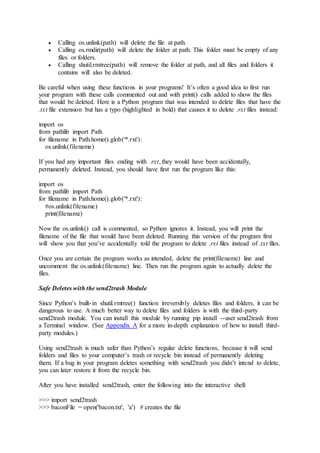
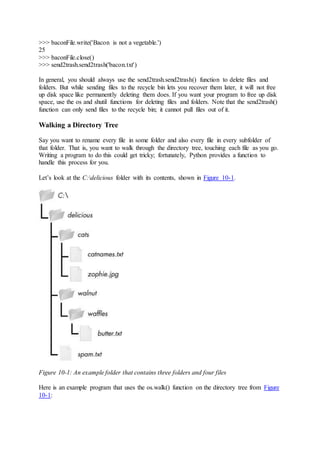
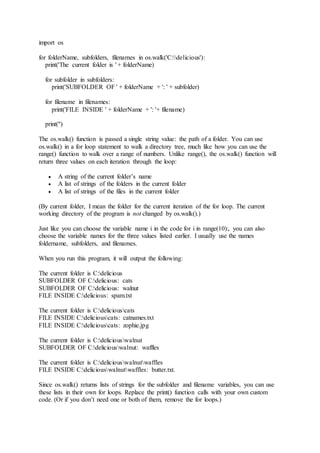
![Compressing Files with the zipfile Module
You may be familiar with ZIP files (with the .zip file extension), which can hold the
compressed contents of many other files. Compressing a file reduces its size, which is useful
when transferring it over the internet. And since a ZIP file can also contain multiple files and
subfolders, it’s a handy way to package several files into one. This single file, called an
archive file, can then be, say, attached to an email.
Your Python programs can create and open (or extract) ZIP files using functions in the zipfile
module. Say you have a ZIP file named example.zip that has the contents shown in Figure 10-
2.
Figure 10-2: The contents of example.zip
You can download this ZIP file from https://nostarch.com/automatestuff2/ or just follow
along using a ZIP file already on your computer.
Reading ZIP Files
To read the contents of a ZIP file, first you must create a ZipFile object (note the capital
letters Z and F). ZipFile objects are conceptually similar to the File objects you saw returned
by the open() function in the previous chapter: they are values through which the program
interacts with the file. To create a ZipFile object, call the zipfile.ZipFile() function, passing it
a string of the .ZIP file’s filename. Note that zipfile is the name of the Python module, and
ZipFile() is the name of the function.
For example, enter the following into the interactive shell:
>>> import zipfile, os
>>> from pathlib import Path
>>> p = Path.home()
>>> exampleZip = zipfile.ZipFile(p / 'example.zip')
>>> exampleZip.namelist()
['spam.txt', 'cats/', 'cats/catnames.txt', 'cats/zophie.jpg']
>>> spamInfo = exampleZip.getinfo('spam.txt')
>>> spamInfo.file_size
13908
>>> spamInfo.compress_size](https://image.slidesharecdn.com/automatetheboringstuffwithpython-220124043644/85/Automate-the-boring-stuff-with-python-7-320.jpg)
